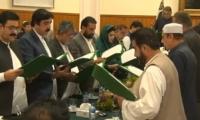While we have known for some time on the basis of reports emerging from the former tribal areas that education was not in a good state, the true extent of the problem is now emerging. According to a monitoring report prepared by the KP Education Department following the merger of these districts into the province, the picture is a very bleak one. The report states that about 40 percent of children remain absent from schools and that of over 500,000 enrolled students nearly 200,000 were found absent. Many of the students never attended school at all. Frontier Region Lakki had the highest number of absent children with 70 percent absent from schools. The former Frontier Regions of Bannu and Tank followed with 60 percent and 59 percent absenteeism. The situation was not much better in the other former tribal districts and regions. What makes matters even more discouraging are reports that suggest the data may be painting a more positive picture than is actually the case. According to newspaper accounts, the visits to the schools were not surprise visits as laid down in the regulations regarding protocol. The main reason for this appeared to be the fact that monitors were not aware of school locations and needed to be guided to them by local officials. It is not illogical to assume the rate of attendance could be even lower on other days.
For many years, the data put together by Fata authorities officially shows that the literacy rate in the now merged districts is below 20 percent in some cases and in certain areas falls to below one percent for girls. Despite this information, very little appears to have been done over the years to improve conditions. The poor condition of government schools, the high rate of absenteeism among teachers and lack of motivation amongst pupils have all contributed to what is an educational crisis. Currently no other part of the world has a literacy rate of below one percent for its women. Following the merger, drastic measures will be needed to bring the former tribal districts and regions at par with the rest of the province. Khyber Pakhtunkhwa has a literacy rate of 53 percent with only Punjab placed higher on the list with 59 percent. Overall Pakistan’s literacy rate is 58 percent. This means a great deal of work will be required to promote enrollment, attendance and quality education in the newly merged districts. The KP government and its education department will need to devise a strategy which can work effectively after consulting all stakeholders.
Representational image. —APP/FileIf you live in Karachi, or anywhere else in Pakistan for that matter, you have...
Screengrab shows X services down in Pakistan. — Geo.tvIt has been two months since social media platform X has been...
Health experts estimate an 8.0 per cent and 5.0 per cent increase in hepatitis B and C related deaths, respectively,...
PTI has managed to carve out a tough-to-defeat position in Pakistan’s politics and polity both
Rain on Sunday alone led to the deaths of 12 people – two in Balochistan, six in Khyber Pakhtunkhwa and four in Punjab
India seems to be following Israel model of carrying out assassinations on foreign soil of people it sees as a threat...







